Java设计模式中共有7种结构型模式:适配器模式、装饰模式、代理模式、外观模式、桥接模式、组合模式、享元模式。其中对象的适配器模式是各种模式的起源,其关系如下面的图: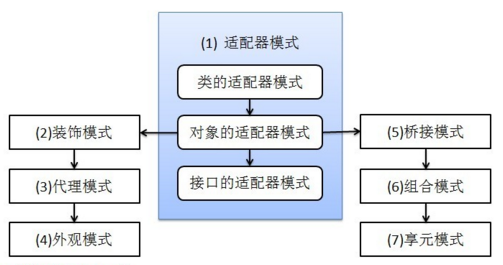
1、适配器模式
适配器模式将某个类的接口转换成客户端期望的另一个接口表示,目的是消除由于接口不匹配所造成的类的兼容性问题。主要分为三类:类的适配器模式、对象的适配器模式、接口的适配器模式。
(1)类的适配器模式
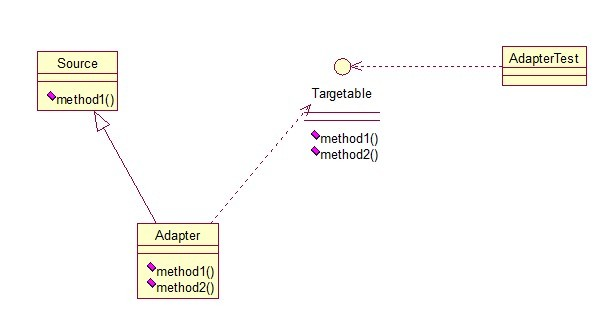
核心思想就是:有一个Source类,其拥有一个方法method1,待适配,目标接口时Targetable,通过Adapter类(继承Source类,实现Targetable接口),从而将Source的功能(method1方法)扩展到Targetable里,看代码:
public class Source {
public void method1() {
System.out.println("this is original method!");
}
}
public interface Targetable {
/* 与原类中的方法相同 */
public void method1();
/* 新类的方法 */
public void method2();
}
public class Adapter extends Source implements Targetable {
@Override
public void method2() {
System.out.println("this is the targetable method!");
}
}Adapter类继承Source类,实现Targetable接口,下面是测试类:
public class AdapterTest {
public static void main(String[] args) {
Targetable target = new Adapter();
target.method1();
target.method2();
}
}输出:
this is original method!
this is the targetable method!
这样Targetable接口的实现类就具有了Source类的功能。
应用场景:
当希望将一个类转换成满足另一个新接口(一个接口就代表一个功能"able")的类时,可以使用类的适配器模式,创建一个新类,继承原有的类,实现新的接口即可。
在本例中即:我们希望Source 类能转换成满足Targetable 的功能()的Adapter 类,则可以将Adapter 类来继承Source 类同时实现Targetable的接口。
(2)对象的适配器模式
基本思路和类的适配器模式相同,只是将Adapter类作修改,这次不继承Source类,而是持有Source类的实例,以达到解决兼容性的问题。
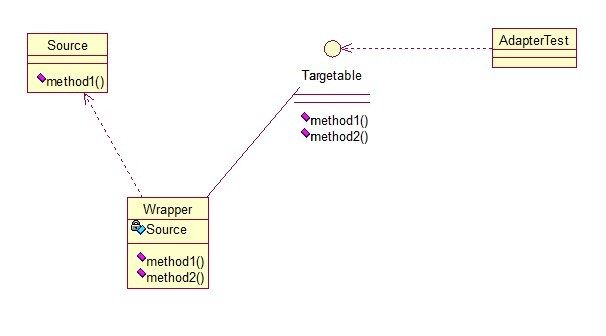
public class Wrapper implements Targetable {
private Source source;
public Wrapper(Source source){
super();
this.source = source;
}
@Override
public void method2() {
System.out.println("this is the targetable method!");
}
@Override
public void method1() {
source.method1();
}
}测试类:
public class AdapterTest {
public static void main(String[] args) {
Source source = new Source();
Targetable target = new Wrapper(source);
target.method1();
target.method2();
}
}输出与第一种一样,只是适配的方法不同而已。
应用场景:
当希望将一个对象转换成满足另一个新接口的对象时,可以创建一个Wrapper类,持有原类的一个实例,在Wrapper类的方法中,调用实例的方法就行。
(3)接口的适配器模式
有时我们写的一个接口中有多个抽象方法,当我们写该接口的实现类时,必须实现该接口的所有方法,这明显有时比较浪费,因为并不是所有的方法都是我们需要的,有时只需要某一些,此处为了解决这个问题,我们引入了接口的适配器模式,借助于一个抽象类,该抽象类实现了该接口,实现了所有的方法,而我们不和原始的接口打交道,只和该抽象类取得联系,所以我们写一个类,继承该抽象类,重写我们需要的方法就行。
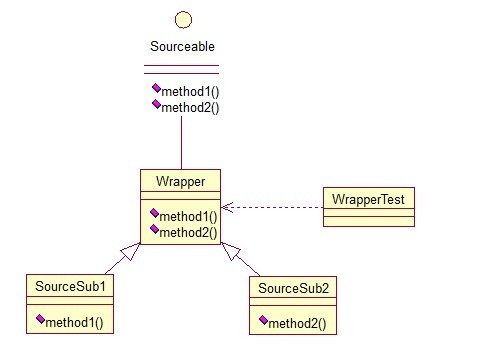
public interface Sourceable {
public void method1();
public void method2();
}抽象类Wrapper2:
public abstract class Wrapper2 implements Sourceable{
public void method1(){}
public void method2(){}
}
public class SourceSub1 extends Wrapper2 {
public void method1(){
System.out.println("the sourceable interface's first Sub1!");
}
}
public class SourceSub2 extends Wrapper2 {
public void method2(){
System.out.println("the sourceable interface's second Sub2!");
}
}
public class WrapperTest {
public static void main(String[] args) {
Sourceable source1 = new SourceSub1();
Sourceable source2 = new SourceSub2();
source1.method1();
source1.method2();
source2.method1();
source2.method2();
}
}测试输出:
the sourceable interface's first Sub1!
the sourceable interface's second Sub2!
应用场景:
当不希望实现一个接口中所有的方法时,可以创建一个抽象类Wrapper,实现所有方法,我们写别的类的时候,继承抽象类即可。
2、装饰模式(Decorator)
顾名思义,装饰模式就是动态的给一个对象增加一些新的功能,要求装饰对象和被装饰对象实现同一个接口,装饰对象持有被装饰对象的实例(这就是装饰的具体操作),关系图如下:
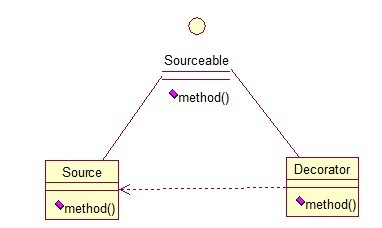
Source类是被装饰类,Decorator类是一个装饰类,可以为Source类动态的添加一些功能,代码如下:
public interface Sourceable {
public void method();
}
public class Source implements Sourceable {
@Override
public void method() {
System.out.println("the original method!");
}
}
public class Decorator implements Sourceable {
private Sourceable source;
public Decorator(Sourceable source){
super();
this.source = source;
}
@Override
public void method() {
System.out.println("before decorator!");
source.method();
System.out.println("after decorator!");
}
}测试类:
public class DecoratorTest {
public static void main(String[] args) {
Sourceable source = new Source();
Sourceable obj = new Decorator(source);
obj.method();
}
}输出:
before decorator!
the original method!
after decorator!
应用场景:
(1)、需要扩展一个类的功能。
(2)、动态的为一个对象增加功能,而且还能动态撤销。(继承不能做到这一点,继承的功能是静态的,不能动态增删。)
缺点:产生过多相似的对象,不易排错!
3、代理模式(Proxy)
代理模式就是多一个代理类出来,替原对象进行一些操作,比如我们在租房子的时候回去找中介,为什么呢?因为你对该地区房屋的信息掌握的不够全面,希望找一个更熟悉的人去帮你做,此处的代理就是这个意思。再如我们有的时候打官司,我们需要请律师,因为律师在法律方面有专长,可以替我们进行操作,表达我们的想法。先来看看关系图:
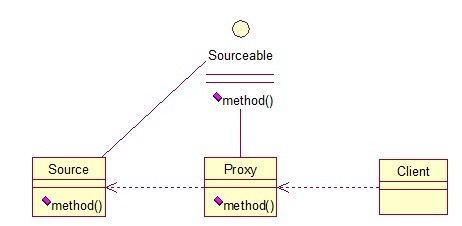
public interface Sourceable {
public void method();
}
public class Source implements Sourceable {
@Override
public void method() {
System.out.println("the original method!");
}
}
public class Proxy implements Sourceable {
private Source source;
public Proxy(){
super();
this.source = new Source();
}
@Override
public void method() {
before();
source.method();
atfer();
}
private void atfer() {
System.out.println("after proxy!");
}
private void before() {
System.out.println("before proxy!");
}
}测试类:
public class ProxyTest {
public static void main(String[] args) {
Sourceable source = new Proxy();
source.method();
}
}输出:
before proxy!
the original method!
after proxy!
应用场景:
如果已有的方法在使用的时候需要对原有的方法进行改进,此时有两种办法:
1、修改原有的方法来适应。这样违反了“对扩展开放,对修改关闭”的原则。
2、就是采用一个代理类调用原有的方法,且对产生的结果进行控制。这种方法就是代理模式。
使用代理模式,可以将功能划分的更加清晰,有助于后期维护!
对比下装饰模式和代理模式,其实在其内在逻辑是一样的,它们都是通过持有目标实例对象来动态地给目标对象增加功能。
4、外观模式(Facade)
外观模式是为了解决类与类之间的依赖关系的,像spring一样,可以将类和类之间的关系配置到配置文件中,而外观模式就是将他们的关系放在一个Facade类中,降低了类与类之间的耦合度,该模式中没有涉及到接口,看下类图:(我们以一个计算机的启动过程为例)
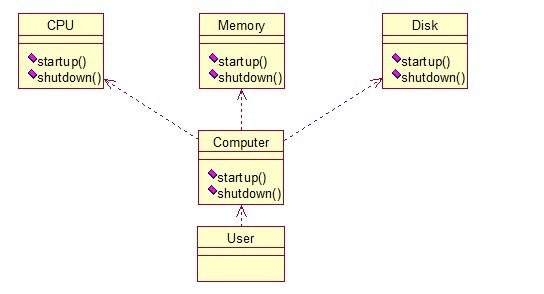
public class CPU {
public void startup(){
System.out.println("cpu startup!");
}
public void shutdown(){
System.out.println("cpu shutdown!");
}
}
public class Memory {
public void startup(){
System.out.println("memory startup!");
}
public void shutdown(){
System.out.println("memory shutdown!");
}
}
public class Disk {
public void startup(){
System.out.println("disk startup!");
}
public void shutdown(){
System.out.println("disk shutdown!");
}
}
public class Computer {
private CPU cpu;
private Memory memory;
private Disk disk;
public Computer(){
cpu = new CPU();
memory = new Memory();
disk = new Disk();
}
public void startup(){
System.out.println("start the computer!");
cpu.startup();
memory.startup();
disk.startup();
System.out.println("start computer finished!");
}
public void shutdown(){
System.out.println("begin to close the computer!");
cpu.shutdown();
memory.shutdown();
disk.